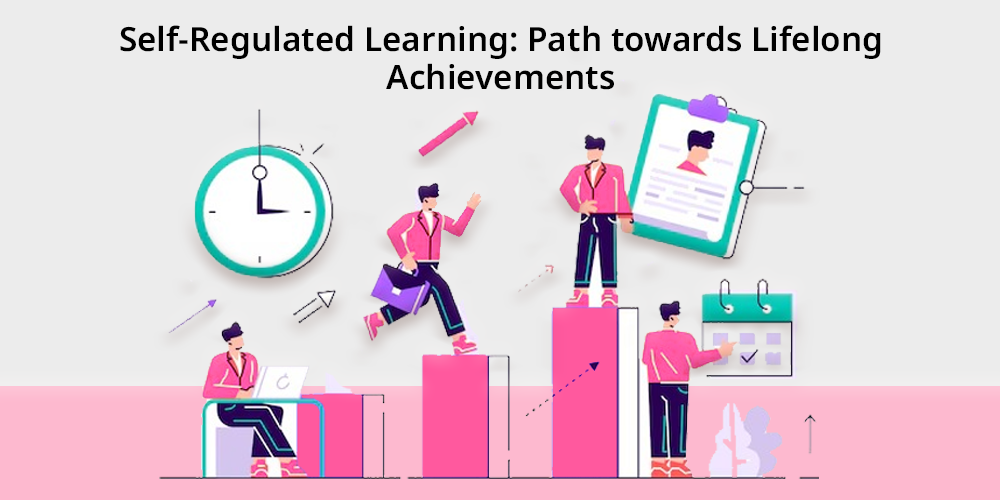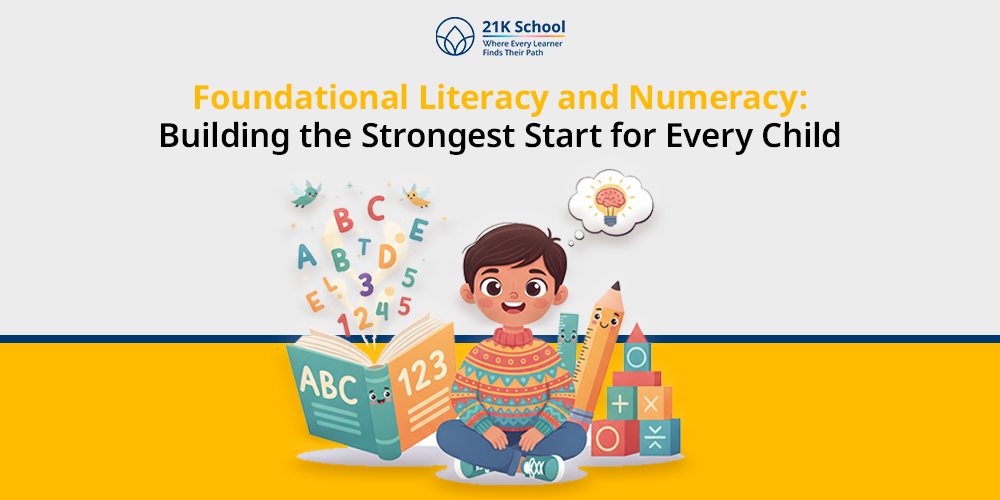
Independent or self-regulated learning in the current rapidly-evolving education world is more relevant than ever. With new information, varied learning contexts and increasing academic demands, students employ to take charge of their own learning.
These skills can truly help them. It is at this point in time that self-regulated learning (SRL) finds its role.
Self-regulated learning gives students control over their learning. Particularly by helping them to formulate learning goals, tracking their progress and analysing results.
While you can take the help of some of the best self-awareness activities for students , self-regulation is not only about academic achievements. It is a life skill that supports independence, self-efficacy and flexibility.
It is important to learn how to self-regulate at any educational stage. Be it at the primary, school level, or to the higher educational level.
Contents
What is Self-Regulated Learning?
Self-regulated learning can be described as learning in which the learners assume self-regulation. This means having goals, choosing proper strategies, checking how they are going on, and evaluating results.
Instead of the learner merely following instructions as passive learners, self-regulated learners engage in the learning process . The idea involves four aspects- cognitive, emotional, motivational and behavioral.
Here, you may focus on why social-emotional learning is important
The self-regulating students do not only know what they are being taught but also how. They think, monitor, correct and assess their procedures to increase knowledge and performance.
Cycle of Self-Regulated Learning
It is commonly considered that self-regulated learning consists of three phases which form a cycle. These stages are connected and in a constant flow of influencing each other.
1. Set Goals, Lay Strategies and Planning
During planning, the learners identify what they need to accomplish. They communicate feasible and measurable targets, decide on the deadline, and pick the strategies they would employ.
Planning this step involves arrangement of study time and problem identification.
Example: A student who is going to take a math test can choose what and how to study. He can spend 30 minutes a day during a week, practice and go through notes.
2. Employ Strategies and Track Performance
It is a phase where the learners take action on their plans. They apply the chosen strategies, monitor their comprehension, and assess their progress concerning their goals.
Monitoring includes interrogating self ( Do I know this concept? ), and assessment of the success of study methods. This is a phase that involves concentration, flexibility and occasional course correction such as changing strategy if it fails.
3. Performance Reflection
Reflecting implies considering what has been done, how that was done and what has been attained as a result. Learners evaluate how well they performed, evaluate what went wrong and what can be made right in the future.
This reflection is used as a feedback to the planning stage to improve next learning cycles.
Why Is Self Regulated Learning Important?
The self-regulated learning fosters many aspects of students that enhances their overall life lessons and lets them thrive in life. We will be getting a detailed description of these reasons in the given section.
1. Improved Academic Scores
Studies have found out that students who use self-improved learning techniques do better at school. They tend to remember more, turn in the work before the deadline, and will have better results on the tests.
2. Learn New Life Skills
The skill of self-directed learning does not finish when formal learning stops. The ability to learn new things and skills on the go, is enabled by self-regulated learning.
This is essential in a fast-changing world. Further, go through the basic life skills not taught in schools
3. Emotional Regulation and Confidence
Students are empowered as they learn to be in command of their learning; this gives the students confidence . This develops emotional resilience as they learn to be resilient in case of failures, assess the mistakes and make adjustments.
4. Effective Student Learning
The self-regulated learner adapts the learning to his/her preferences and needs. Such a degree of personalization creates a more active and effective learning process particularly, in settings with varying student capabilities.
Key Components and Processes
Self-Regulated learning is a multidimensional affair and it encompasses the following:
- Metacognition: Reasoning about thinking. It entails strategic planning, observation, and analysis of one learning.
- Motivation: Feeling that one is capable of success. Most self-regulated learners are self-driven.
- Behavioral Management: Being able to order their school work, using time and consulting when requirements cannot be met.
- Emotional Regulation: The ability to regulate irritation, tension or boredom to remain on track.
A combination of these ensures a balanced learner who is ready to handle challenges without the supervision of anyone.
Strategies to Promote Self-regulated Learning
Self-regulated learning can be hard to implement without correct navigation. An easy blueprint is required to help students with that.
1. Dynamic Cognitive Approaches to Learning Strategies
Train children on the ability to meditate at the study mode that suits them the best. Ask them to use different strategies, like making summaries, drawing diagrams, or explaining them to another person and evaluate efficiency.
2. Model Goal-directed Behaviour
Teachers and parents must demonstrate how to determine clear and achievable objectives and how to remain oriented on them. It is important to show that planning and perseverance pays.
3. Use the Discourse of Self-Regulation Frequently
Set up constant classes to review their learning processes. This might be in the form of peer sharing, journals or class discussions of what does or does not work.
4. Planning Classwork
Encourage the students to subdivide huge work into small tasks. It can help make it less overwhelming to have planning and offer checklists or visual organizers. You can make them understand the classroom discipline for proper planning.
5. Direct Strategy Discussion
It is not enough to give the assignments but to discuss how to do them. Explain various approaches that students can apply, when it is suitable to apply them and the reasonability.
6. Reflective and Feedback
Use constructive, timely feedback and create time to reflect. Ask students to be critical and really consider what feedback is and what they can do with it.
7. Watch out With Best Judgement
Teach the students how to know whether they are using an effective learning strategy. They ought to learn to change things when something is not working instead of proceeding without thinking about it.
Benefits of Self-Regulated Learning
It is seen that self-regulated learning assists students in growing themselves into an epitome of success, if followed honestly. They can improve your multiple dimensions of life, be it social, cultural, emotional, or cognitive.
1. Better grades in school
Self-regulated learners have better chances of performing well in academics since they are the owners of their education. They do better in assignments, tests and coursework much by setting their goals and selecting the right study strategies.
These are active, not passive students when it comes to learning.
2. More Motivation and Involvement
Since SRL promotes autonomy, the chances are high that students will become motivated and feel proud of their work. The urge to learn is internally motivated instead of being driven by external forces.
Example: Curiosity or a need to learn a skill instead of getting motivated by grades or external pressure.
3. Improved Organizing and Time Management
Autonomous learners set routines, small their activities into manageable parts and adhere to timetables. This enables them to shun last minute revision, decreases stress and improves productivity.
It makes learning easier to handle. Learn more on time management skills .
4. Increased Flexibility and Problem solving
Self-monitoring allows students to be more aware of what is not going well and change to more effective strategies. Such power to adapt facilitates flexibility, and enables them to survive in school and life. Understand more about problem-solving for a detailed perspective.
5. Increased levels of Confidence and Self-Efficacy
Every time learners define a goal and accomplish it by means of self-regulation, they become confident. The students start to accept that they can learn anything through effort and smarts.
Such an attitude brings forth persistence even when things are hard.
6. Advance Lifelong Learning
SRL is not only helpful at school, but provides skills for lifelong learning . Individuals who monitor their learning will be entitled to practice their new skills many years after their education.
Connection with this can be particularly helpful in our rapidly-evolving world where learning must be ongoing.
Challenges of Self-Regulated Learning
Self-regulated learning does not just come with all the advantages. It has few drawbacks that makes it harder to incorporate into students’ life.
These considerations are crucial to tackle for an uplift of students’ performance.
1. Demands a Lot of Discipline and Maturity
One of the greatest problems of SRL is the fact that it requires strict personal student discipline . Younger or inexperienced learners can have trouble planning, time management, or staying focused without an outsider helping them.
2. May be Exhausting Unless Well Supported
Self-regulation will become a burden to a student whose executive functional skills are not completely developed yet. Without scaffolding or training, they will likely come to feel lost and frustrated, as a result becoming less motivated.
3. Does not Always get Nurtured in Traditional classrooms
Standardized teaching in many education systems results in little space to set their own goals, and to consider strategies. This may restrict the SRL practicing among students.
4. Ambiguity of Erroneous Judgments
Students without precise self knowledge can never estimate their ability well. As an example, a student may think that they know a subject matter quite well and opt not to review yet they do not perform well.
Not seeing their performance correctly can lead to setbacks.
5. Differential Access to Resources
Sometimes good SRL relies on the availability of resources such as planners, silent study spaces, internet, or mentors. These limitations can prevent students with disadvantaged backgrounds to fully engage in self-regulated practices.
In Conclusion
Self-regulated learning is an effective process that turns students into self-directed and autonomous learners. It does not only encourage school-based success but also facilitates future learning, perseverance, and flexibility.
SRL can keep students ready in and out of the classroom by teaching metacognition, motivation, and strategic behavior. These skills are fostered by the teachers, the parents and of course the learners themselves. Self-regulated learners can be confident learners with proper strategies and firm work. So, go and encourage your kids to become one.

